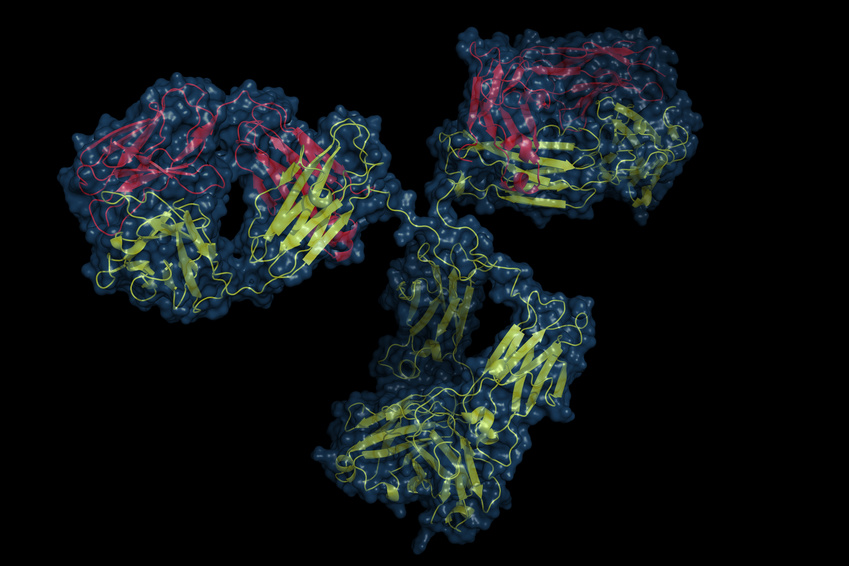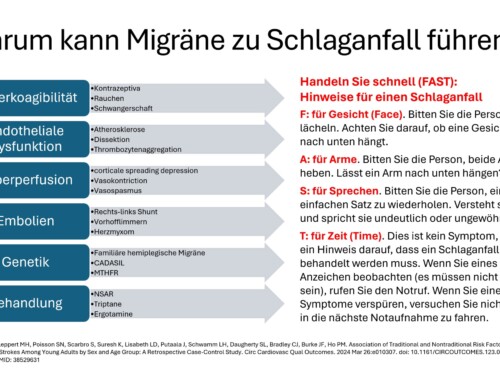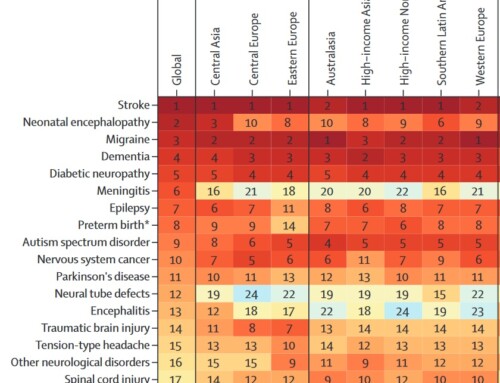Migraine is one of the most serious disabling diseases affecting humanity. According to a current overview by the WHO, migraine is listed as the 6th most disabling disease. If you take into account the complication of headaches caused by medication overuse, migraines take third place. If you combine the various forms of the 367 types of headache known today, migraines and headaches are by far the most severe, common and severely disabling human diseases.
The current treatment options for migraines include preventive therapies and the treatment of acute headache attacks. A significant proportion of those affected do not find sufficient improvement through preventative therapy procedures. Even the current attack therapy cannot achieve effective relief with the previous therapy options; there may be contraindications or intolerances.
Current studies in recent years have provided numerous evidence that calcitonin gene-related peptide, or CGRP for short, plays a significant role in the development, maintenance and chronification of migraines. CGRP is a neuropeptide consisting of 37 amino acids. It is encoded by the same gene as the hormone calcitonin.
CGRP has therefore been brought into the focus of new migraine treatment options. The development of CGRP receptor antagonists, the so-called Gepante, represent a new class of drugs for the acute treatment of migraine attacks. However, their development was stopped due to liver toxicity.
Current research is intensively aimed at developing monoclonal antibodies against CGRP. Both vascular and neuronal mechanisms play a role in the complex migraine pathophysiology. Serotonin (5-hydroxytryptamine, 5-HT), nitric oxide and CGRP are key messenger substances involved in the development of migraine pain. CGRP consists of 37 amino acids. It was discovered about 30 years ago. CGRP is found widely in the peripheral and central nervous systems. Every major organ is innervated by nerve fibers containing CGRP. In particular, CGRP and CGRP receptors are found in anatomical structures that are important for the development of migraines. These include the cerebral cortex, meninges, hypothalamus, cerebellum and brainstem. CGRP is also found in many neurons that are important for the trigeminovascular pain processing system. In the trigeminal nerve, CGRP can be found in over 50% of the neurons. CGRP is also important in pain processing in the brainstem. It leads to a sensitization of the perception of stimuli. In the periphery, CGRP is released by neurons that innervate blood vessels, particularly in the cardiac and intracranial vessels. CGRP leads to pronounced and sustained vasodilation. This is mediated by the activation of receptors in smooth muscle cells. These processes are significantly relevant to neurogenic inflammation. The result is vasodilatation, sensitization, swelling and other inflammatory mechanisms.
Initial findings have shown that at the onset of a migraine attack, CGRP leads to dilatation of the middle cerebral artery and the middle meningeal artery. Further studies demonstrated that CGRP triggers and maintains both peripheral and central sensitization. Sensitization is considered a fundamental step in the development of the migraine attack and the chronicity of the disease. The neurogenic inflammation associated with the migraine attack is modulated by CGRP release directly due to vasodilatation and indirectly due to the release of substance P resulting in plasma extravasation. In addition, mast cell degranulation is caused and the release of pro-inflammatory and inflammatory substances is triggered. The release of cytokinins leads to sensitization of sensory neurons. As a neuromodulator, CGRP activates synaptic glutamate transmission in the dorsal horn and trigeminal nucleus. This leads to a further central increase in the sensitization and activation of nociceptive reflexes. Pain behavior is also activated by activating central neurons, particularly in the amygdala. Fear and avoidance behavior are also influenced. The initiation of the migraine attack is associated with cortical spreading depression (CSD). The neuronal activity of the cerebral cortex is locally reduced or completely interrupted. This depolarization gradually spreads spatially over the cerebral cortex, analogous to the spread of migraine aura. CSD leads to release of CGRP resulting in neurogenic inflammation including sensitization, hyperemia, vasodilation, swelling, and functional impairment.
Studies also show that CGRP is involved in the development of hypersensitivity to sensory stimuli, particularly photophobia. Since CGRP can also be released extensively in the enteric nervous system, it is believed that gastrointestinal symptoms such as gastric stasis, nausea and vomiting are modulated by CGRP mechanisms.
The connection between the development of migraines and CGRP initially emerged from the discovery that stimulation of the trigeminal ganglion leads to the release of CGRP. CGRP is found in elevated concentrations in the jugular vein during a spontaneous migraine attack. Increased CGRP concentrations are also found in saliva during an acute migraine attack. These can be reduced by treatment with a triptan. CGRP levels are also increased between migraine attacks in patients with migraine.
Intravenous administration of CGRP can directly trigger migraine attacks in migraine sufferers. Patients who do not suffer from migraines experience headaches without the typical symptoms of migraines after administration of CGRP. It is therefore believed that migraine sufferers have a particular sensitivity to CGRP. Finally, selective blocking of the CGRP receptor can effectively stop an acute migraine attack.
CGRP receptor antagonists
Based on these findings, various approaches have been systematically pursued in recent years to therapeutically use the new findings about CGRP in migraine pathophysiology. As a completely new class of migraine medications, the so-called Gepante were initially developed as CGRP receptor antagonists. Their mechanism of action was based on the competitive inhibition of the body's own CGRP at the CGRP receptor. Six different Gepantes have now been developed and tested in clinical studies. The result was a clinical effect that was significantly superior to that of placebos, but comparable to that of triptans. The main advantage of Gepante is that, unlike triptans, they do not lead to vasoconstriction. The development of CGRP antagonists was halted due to liver toxicity in long-term use and because they were not more effective than triptans. However, their mode of action demonstrated the important role of CGRP in migraine pathophysiology and the possibility of using CGRP in the treatment of migraine.
Monoclonal antibodies against CGRP
The biological effect of CGRP can alternatively be blocked by monoclonal antibodies against the CGRP itself or against the CGRP receptor. There are currently four monoclonal antibodies for the preventative treatment of episodic or chronic migraine. The neuropeptide itself is targeted by three monoclonal antibodies, ALD-403 (Alder Biopharmaceuticals), LY2951742 (developed by Arteau's Therapeutics and further development by Eli Lilly) and LBR-101, current name TEV-48125 (developed by Labrys Biologics-Pfizer, acquired by Teva Pharmaceuticals). A fourth monoclonal antibody targets the CGRP receptor itself, AMG334 (Amgen, Inc.; further development by Novartis).
ALD403 will be infused at 3 month intervals. Results of a phase 2b study are expected in July 2016 for the prevention of chronic migraine. A phase 3 study is investigating the prevention of frequent episodic migraines. The study is scheduled to end in April 2017. Another phase 3 study is scheduled to start in 2016. In addition, a phase 2b study will analyze self-administration by patients for episodic migraine for ALD403.
TEV-48125 is currently being studied in a Phase 3 study. The analysis of effectiveness for chronic migraines is scheduled to be completed in October 2017.
LY2951742 was studied in a Phase 2 study completed in August 2015. The preventive effect on episodic migraine was analyzed by subcutaneous administration at intervals of four weeks over a period of 12 weeks. It was found to be significantly effective compared to placebo in reducing the number of migraine days. Further phase 3 studies are currently being carried out. An efficacy study for episodic migraine is expected to be completed by December 2017. Another study on effectiveness for chronic migraines is scheduled to be completed in April 2018. An additional open long-term study is scheduled to be completed in September 2017.
AMG334 is currently being investigated in a phase 2 study for its preventive effect on chronic migraines. The long-term effects and safety will be analyzed in another phase 2 study and should be completed by July 2017. Two phase 3 studies on the preventive effect on episodic migraine are scheduled to be completed by October 2017 and February 2018, respectively.
Tolerability and safety
In view of the experience with the development of CGRP antagonists, the results regarding the tolerability and safety of the monoclonal antibodies against CGRP in the long-term studies must be awaited. The antibodies do not selectively block CGRP-mediated vasodilation throughout the body. Effects on the inhibition of cardiovascular vasodilation, for example during stress or ischemia, as well as the interactions in the treatment of arterial hypertension are open. Interactions on cardiac and cerebral blood flow are conceivable. However, previous studies showed no effects on the ECG or other hemodynamic parameters. The possible induction of immunological reactions in the patient to the administration of the monoclonal antibodies is also unclear.
effectiveness
There is no doubt that current preventive treatment options for migraine are unsatisfactory for many patients. The monoclonal antibodies are also not effective in some of the patients examined in the previous study programs. For example, 47% with a low dose and 45% with a high dose of TEV-41825 did not achieve a 50% reduction in migraine frequency in terms of headache days. The following still applies: Migraine is a complex disease that is mediated by very different pathophysiological pathways and a wide variety of molecules. The importance of CGRP varies from patient to patient. However, there appears to be a subgroup of patients who respond very effectively to treatment with monoclonal antibodies against CGRP. More than 15% of the treated patients reported a complete cessation of migraine attacks. For some patients, the treatment will therefore contain very effective options, but others will not benefit sufficiently from it. What also remains to be seen is the comparative effectiveness with previous preventative medications. However, it is already clear that the prevention of migraines must involve various strategies. Differentiated individual therapy is necessary in each individual case, especially in severe and chronic cases. A treatment that stops migraines with an injection and allows you to live as you want cannot be expected, even with monoclonal antibodies.











I have suffered from migraines for 30 years.
At hard times with 2 attacks 3 days a week. With 7 days out of a week there isn't much viable time left. I also agree with the comments that I will immediately make myself available for a study.
Due to the many tablets, I have already gone through withdrawal for several months due to tablet-induced headaches.
I hope for an improvement so that I don't lose my job too.
I agree with Ms. Gilles. I'm almost 50 and have struggled with migraines since I was a teenager. Unfortunately, the hope that things would get better with menopause has not yet materialized for me. If you have a need for study participants. I'm there!
I too have suffered from severe migraines and tension headaches for 28 years. I am currently experiencing a period of intense pain again, so much so that I cannot work. I am 57 years old and have almost given up all hope of being pain free. I would be very happy if I could test this antibody injection.
I have been suffering from migraines for 45 years and was unable to work due to chronic migraines.
Currently 10-15 days a month. Thanks to Ascotop I can somehow cope with this now. I would immediately make myself available to take part in studies.
I'm still hoping for the vaccination, and I'm afraid what will happen with the medication as I get older (I'm almost 60).
It would be nice if I lived to see this revolution.